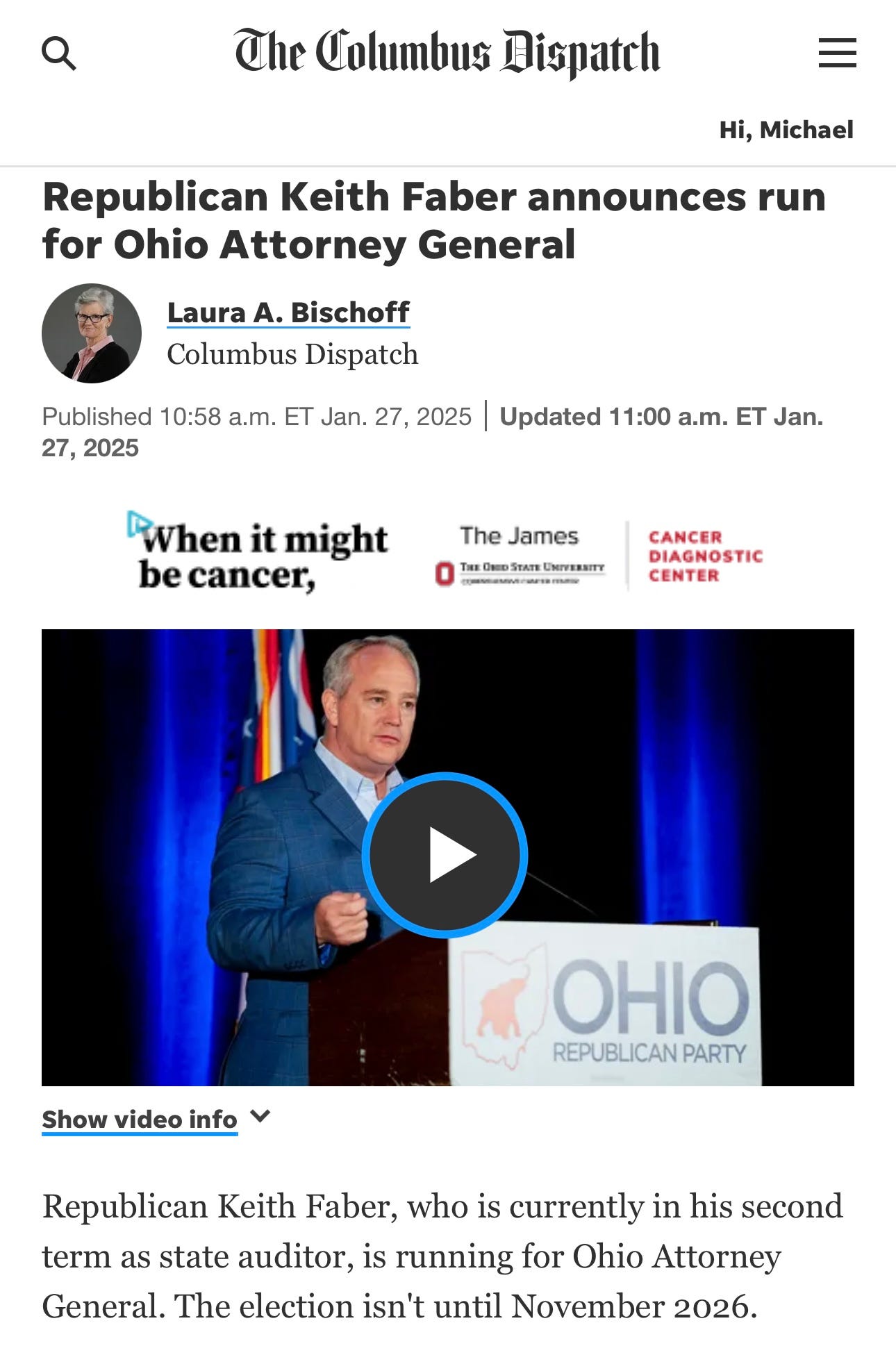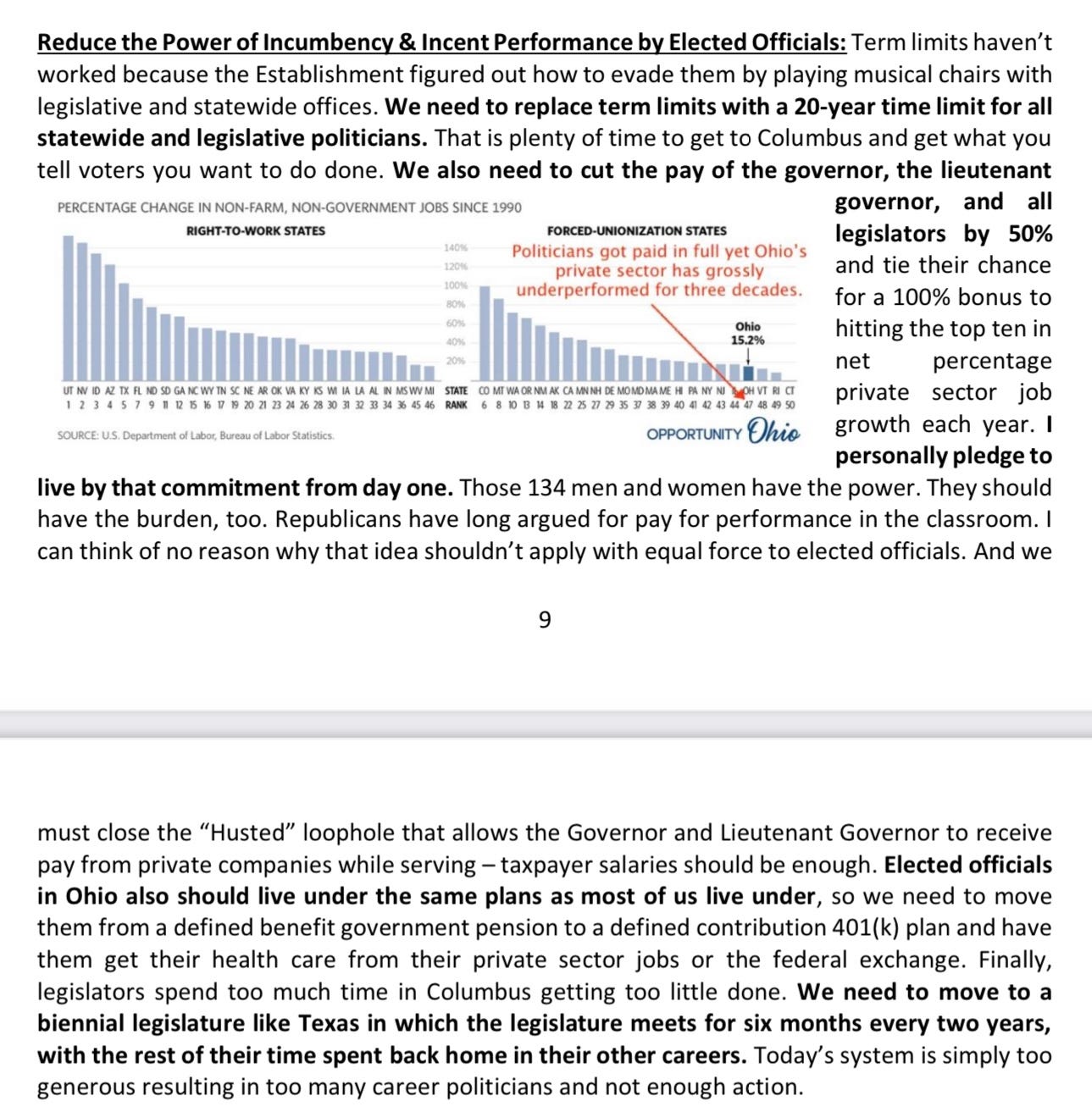Ohio Education Results Show Pandemic Shutdown Devastation — Plus, Another Case for Replacing Term Limits With a 20-Year Time Limit
Without key political reforms, Ohioans won’t get the vital policy reforms they desperately need to thrive.
On an issue closer to home, I came across the latest scores for Ohio’s 4th and 8th graders in the National Assessment of Educational Progress. The report cards below cover from 2011 to 2022 for both grade levels in math and reading. I focused on this timeframe because Republicans have controlled Ohio throughout this era with John Kasich and Mike DeWine in the governor’s office and supermajorities in both chambers of the Ohio General Assembly. Thus, this report card vividly shows whether Republicans were good or bad stewards of Ohio educational policy. As you can see, the number of kids at or above basic and at or above proficient in math and reading among 4th graders dropped in all cases except a minor bump of one point in reading for those at or above proficient. For 8th graders, the drop in numbers was more significant and across the board. These scores mean that an increasing number of Ohio K-12 graduates won’t be at or above a basic level of math and reading skills as they enter the workforce. These deficiencies will undermine Ohio’s private sector.
The severe pandemic shutdown of our schools by the DeWine-Husted Administration based on the terrible advice of 2026 Democrat gubernatorial candidate Amy Acton did enormous damage to our kids’ educations. For 8th graders, half or more of the drop in both math and reading since 2011 occurred from 2019 to 2022, with similar results for 4th graders. Thus, the pandemic shutdown is unequivocally the cause of the drops. It likely will take years to improve those scores back to the 2011 level. If Ohio policymakers want to give our kids the best chance to succeed in school, they should enact universal school choice in which 100% of state funds follow each student to that student’s school of choice regardless of whether that school is public, private, parochial, or charter. This single action would instantly inject massive competition into Ohio’s K-12 educational system, especially in Ohio’s urban schools that are failing scores of kids who are least able to overcome educational deficits. As with so many key issues in Ohio, nibbling on the margins is simply unacceptable.
In a recent study,"Lack of correlation between school reopening and trends in adult COVID-19 hospitalisations and death rates during the Delta and early Omicron periods: An ecological analysis of five countries,” published in the Journal of Infection, the authors concluded:
Our findings show that there were no consistent patterns to case, hospitalisation or death rates in each country or jurisdiction, irrespective of whether schools were open for onsite learning or changes to PHSM. School closures were adopted by many countries as part of a suite of PHSM but in the future should only be implemented where there is strong evidence of effectiveness. Predesigned and approved study protocols, along with scenario-based planning for schools are needed to prepare for the next pandemic. The negative consequences on child health and development are profound, so understanding the role of schools in SARS-CoV-2 transmission should be a priority for pandemic preparedness and response.
The punchline: DeWine, Husted, and Acton should not have ordered Ohio’s schools (or its businesses or houses of worship) closed, as those closing had no impact on the physical health of Ohioans while the closings decimated our kids’ educations and the mental health of millions. DeWine is thankfully done politically. Husted is up for reelection in 2026 and Acton will be on the ballot then, too. Ohioans must hold them both accountable for their egregious political malpractice that did so much harm to Ohio, its people, and its businesses.
Most egregiously, not one of them has ever apologized for being wrong and doing untold damage to millions of Ohioans.
On a related note re ineffective career politicians (DeWine has spent eighteen years in Columbus with Husted coming in at twenty-four years), State Auditor Keith Faber announced that he will run for Ohio Attorney General (AG) in 2026. Faber has been in Columbus for twenty-four years already. Should he win the AG’s office, he will have spent thirty-four years on the taxpayer dole racking up one hell of a taxpayer-funded government pension. Faber will be 70-years-old at the conclusion of his AG service, so I presume he will then run for governor in 2036. That is how the musical chairs game is played among statewide office holders—they switch roles until they can finally get their shot at being governor. As with DeWine (Lieutenant Governor and AG) and Husted (Secretary of State and LG), Faber’s time in Columbus covers the entire time in which Ohio has fallen farther and farther behind other states with anemic private sector job creation, stagnant population growth, increased government dependency, skyrocketing state spending, and, as detailed above, damning K-12 educational outcomes.
I don’t mean to pick on Faber, as he is a perfectly decent man. David Yost is running for governor after spending eight years as AG and eight years as Auditor.
Faber is simply another great example of why Ohioans need to replace term limits, which haven’t worked (see Kirk Schuring who spent twenty-nine years in the legislature AFTER term limits were passed), with a 20-year time limit for anyone in the legislature and statewide offices. I outlined this proposal during my exploratory run for governor. Essentially, my time limits proposal works like this: the moment an Ohioan is elected to the Ohio General Assembly or a statewide office, his 20-year clock begins ticking. Once he hits twenty years, he is sent home for good never to darken state politics again. The idea is if someone needs more than twenty years to get what they want to get done, then they must not be that talented so we need to make room for more talented people with fresh blood and new ideas. This policy change will end the shenanigans in which legislators endlessly flip seats with each other from the Ohio House to the Ohio Senate and back again, as Schuring did with Scott Oelslager ( who has continuously been in the legislature for forty years and counting) and the statewide musical chairs game played by those legislators with gubernatorial aspirations.
Imagine for a minute if a Fortune 500 company was run this way; meaning, C-Suite executives swapped positions (Chief Financial Officer, Chief Legal Officer, Chief Human Resource Officer, Chief Information Technology Officer, and Chief Security Officer) every eight years until each got “her turn” as the Chief Executive Officer. No sane person would invest in such a company and it would rapidly implode due to ineffective leadership. Yet, that is EXACTLY how Ohio is run and EXACTLY why it isn’t being run well. Where is the top accountant who just wants to serve as Treasurer then return to private practice or the big firm lawyer who just wants to be AG then return to her law firm or the successful business owner who just wants to be governor to finally fix Ohio then ride off into the sunset (which was my plan)? Every eight years, the same politician who told us he really wanted to be the Treasurer to "blah, blah, blah" then tells us he now really wants to be AG to "blah, blah, blah," which will end when he tells us he really wants to be governor to "blah, blah, blah." In this case, the “blah, blah, blah” means to continue the status quo given that he is inheriting his office from his fellow Republican buddy who inherited it from his fellow Republican buddy who all were just biding time until they could run for governor to continue the status quo. Not one of these career politicians puts out a Reaganesque bold color agenda for Ohio that will move Ohio from the back of the pack to the front of the pack on issue-after-issue. They merely regurgitate the same gubernatorial talking points (I’m going to cut taxes, reduce regulations, and protect life and guns) election-after-election that do little to change Ohio’s downward trajectory.
It is maddening, especially because these men are largely funded by wealthy successful business owners who would never have run their companies this way and who fiddle as Ohio burns for the middle and lower classes. Replacing term limits with a time limit will stop this madness thereby giving Main Street Ohioans a chance to finally prosper. Without key political reforms, Ohioans won’t get the vital policy reforms they desperately need to thrive.
P.S. As I wrote in my last column, The Heritage Foundation is now out with report echoing my 2017 column re war against the Mexican drug cartels. Glad to see my former colleagues at Heritage join me eight years later:-)
P.P.S. The Vivek for Governor effort has released some names of people engage in helping Ramaswamy and, thankfully, there are no Kasich hacks on the list (Jai Chabria was pushed out of Team Kasich during the second term, so he shouldn’t be seen as a Kasich soldier). Perhaps someone read my advice column to Ramaswamy, so nixed the hiring of Kasich adherents. I’ve been informed Ramaswamy indicated that his views on Ohio “align” with my 2023 Reaganesque bold colors agenda for Ohio, but I’ve not heard personally from Ramaswamy or his team so time will tell.








Matt,
20 years??? How about a total of 12 Years and, let's get rid of the pension and medical. Being an elected official shouldn't be a career and it shouldn't be rewarded as such. Most people I talk to would recoil at 20 years, way too much.
Jim Lewis
The line that I think summarizes the "Republican" Dark Fakery is this:
"Most egregiously, not one of them has ever apologized for being wrong and doing untold damage to millions of Ohioans."
Exactly! They would do it again tomorrow. OUT, OUT, OUT...ALL who failed to raise their voices to fight the egregious abuse of their constituents.